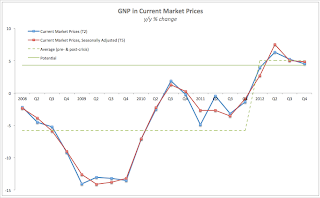CSO have released the latest (3Q 2019) data for the National Accounts. The headlines are covered in the release here: https://www.cso.ie/en/releasesandpublications/er/na/quarterlynationalaccountsquarter32019/ and are worth checking. There was a massive q/q increase in GNP (+8.9%) and a strong rise in GDP (+1.7%).
Official value added q/q growth figures were quite impressive too:
- Financial & Insurance Activities value added was +5.7 percent in volume, all of which, judging by the state of the Irish banks came probably from the IFSC and insurance premiums hikes
- Professional, Administrative & Support Services +5.1 percent (this sector is now heavily dominated by the multinationals)
- Public Administration, Education and Health sector lagged with a +1.5 percent
- Arts & Entertainment +1.8 percent
- Construction grew by much more modest +1.3 percent
- Industry (ex-Construction) fared worse at +1.1 percent
- Information & Communication increased by 0.8 percent over the same period
- Meanwhile, more domestic-focused Agriculture recorded a decline of 3.2 percent
- Distribution, Transport, Hotels & Restaurants posted a decline of 1.0 percent.
On the expenditure side of accounts:
- Personal Consumption Expenditure increased by 0.9 percent q/q
- Government expenditure increased 1.2 percent.
Not exactly the gap we want to see, especially during the expansionary cycle, but public consumption has been running below private consumption in level terms ever since the onset of the recovery.
With this in mind, here is what is not discussed in-depth in the CSO release. CSO reports a measure of economic activity that attempts to strip out some (but not all) of the more egregious effects of the tax optimising multinational enterprises' on our national accounts. The official name for it is 'Modified Domestic Demand', "an indicator of domestic demand that excludes the impact of trade in aircraft by aircraft leasing companies and trade in R&D service imports of intellectual property". Alas, the figures do include intangibles inflows, especially IP on-shoring, income from domiciled intangible assets, and transfer pricing activities. Appreciating CSO's difficulties, it is virtually impossible to make a judgement as to what of these three components is real (in so far as it may be actually physically material to Irish enterprises and MNCs trading from here) and what relates to pure tax optimisation.
With liberty not permitted to CSO, let's take the two categories out of the aggregate modified demand figures.
So, this good news first: Modified Total Domestic Demand is growing and this growth (y/y) is improving since hitting the recovery period low in 3Q 2018.
Bad news: growth in modified domestic demand remains extremely volatile - a feature of the Irish economy since mid-2014 when the first big splashes of the Leprechaun Economics started manifesting themselves (also see last chart below).
Not great news, again, is that domestic growth is not associated with increases in investment (first chart above, blue line).
More good news: in levels terms, adjusting for inflation, Ireland's Modified Domestic Demand has been running well-above pre-crisis period peak average levels for quite some time (chart below). Even better news, it appears that much of the recent support for growth in demand has been genuinely domestic.
Next chart shows y/y growth rates in the headline Modified Total Domestic Demand as reported by the CSO (blue line) and the same, less transfer pricing, stocks flows and IP flows (grey line).
Starting with mid-2014, there is a massive variation in growth rates between the domestic economy growth rates as reported by the CSO and the same, adjusting for MNCs-dominated IP and transfer pricing flows, as well as one-off effects of changes in stocks (inventories). There is also tremendous volatility in the MNCs-led activities overall. Historically, standard deviation in the y/y growth rates in official modified domestic demand is 5.68, and for the period from 3Q 2014 this is running at 5.09. For modified demand ex-transfer pricing, IP and stocks flows, the same numbers are 6.12 and 1.62.
Overall, growth data for Ireland has been quite misleading in terms of capturing the actual tangible activities on the ground in prior years. But since mid-2014, we have entered an entirely new dimension of accounting shenanigans by the multinationals. Much of this is driven by two factors:
- Changes in tax optimisation strategies driven by the international reforms to taxation regimes and the resulting push by the Irish authorities to alter the more egregious loopholes of the past by replacing them with new (IP-related and intangible capital-favouring) regime; and
- Changes in the ays in which MNCs prioritise specific investment inflows into Ireland, namely the drive by the MNCs to artificially or superficially increase tangible footprint in the Irish economy (investment in buildings, facilities and on-shored employment) to provide cover for more tax-driven FDI.
Time will tell if these changes will lead to more or less actual growth in the real economy, but it is notable that the likes of the IMF have recently focused their efforts at detecting tax optimising activities at national levels away from income flows (OECD approach to tax reforms) to FDI stocks and firm-level capital activities. By these (IMF's) metrics, Ireland has now been formally identified as a corporate tax haven. How soon before the OECD notices?..















































